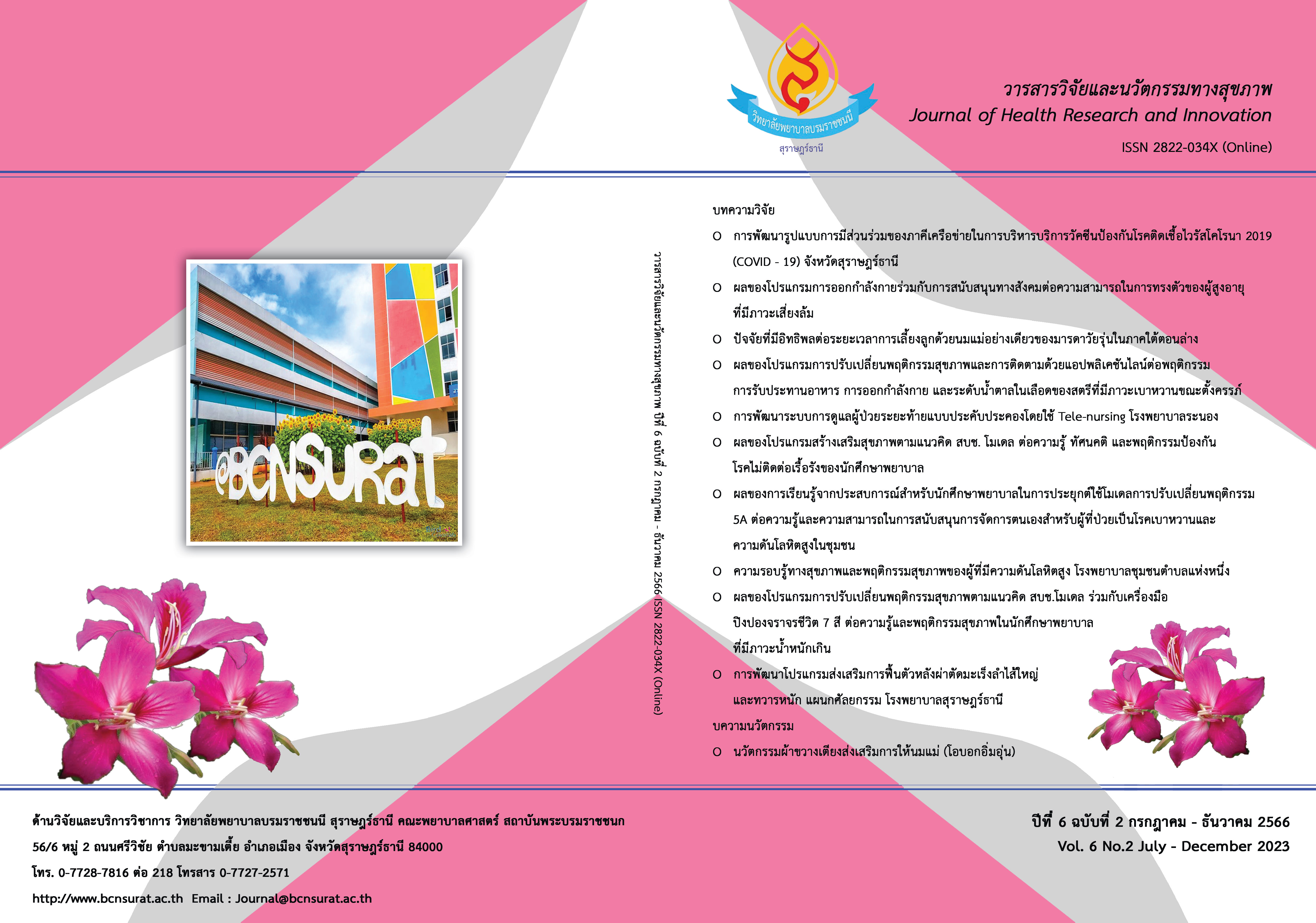การพัฒนารูปแบบการมีส่วนร่วมของภาคีเครือข่ายในการบริหารบริการวัคซีนป้องกันโรคติดเชื้อไวรัสโคโรนา 2019 (COVID - 19) จังหวัดสุราษฎร์ธานี
คำสำคัญ:
การบริหารจัดการวัคซีน, วัคซีนโควิด-19, แนวคิดลีนบทคัดย่อ
การบริหารจัดการวัคซีนโควิด-19 ที่ได้มาตรฐานและครอบคลุมสามารถป้องกันการติดเชื้อและลดความรุนแรงของโรคได้ การวิจัยเชิงปฏิบัติการแบบมีส่วนร่วมมีวัตถุประสงค์เพื่อพัฒนาและประเมินรูปแบบการมีส่วนร่วมของภาคีเครือข่ายในการบริหารบริการวัคซีนป้องกันโรคติดเชื้อไวรัสโคโรนา 2019 (COVID-19) จังหวัดสุราษฎร์ธานี โดยแบ่งการศึกษาออกเป็น 3 ขั้นตอน ได้แก่ 1) การพัฒนารูปแบบ 2) การนำรูปแบบที่พัฒนาไปปฏิบัติในทุกอำเภอภายใต้การมีส่วนร่วมของผู้บริหารบริการวัคซีนระดับอำเภอ และขั้นตอนที่ 3 การประเมินผลการใช้รูปแบบ กลุ่มเป้าหมายคัดเลือกแบบเฉพาะเจาะจงตามเกณฑ์การคัดเข้าของกลุ่มตัวอย่าง วิเคราะห์ข้อมูลเชิงปริมาณด้วยสถิติเชิงพรรณนา และสถิติทดสอบทีแบบสัมพันธ์กัน (Paired t-test)
ผลการศึกษาพบว่ารูปแบบการมีส่วนร่วมของภาคีเครือข่ายในการบริหารบริการวัคซีน COVID-19 พัฒนาตามแนวคิดแบบลีน (Lean) และกระบวนการมีส่วนร่วม ส่งผลให้อัตราความครอบคลุมการฉีดวัคซีน โควิด-19 ในประชากรทุกกลุ่ม ฉีดวัคซีนเข็มที่ 1 ร้อยละ 87.52 เข็มที่ 2 รอยละ 86.49 เข็มที่ 3 รอยละ 54.98 ผู้รับผิดชอบศูนย์ฉีดวัคซีนระดับอำเภอ มีความเข้าใจและสามารถดำเนินงานตามรูปแบบอยู่ในระดับมากที่สุด ผลการเปรียบเทียบความพึงพอใจของกลุ่มบุคลากรและภาคีที่เกี่ยวข้องพบว่าหลังการใช้รูปแบบมีความพึงพอใจสูงกว่าก่อนการใช้รูปแบบอย่างมีนัยสำคัญทางสถิติ (p<.001) ทั้งนี้รูปแบบการบริหารจัดการบริการวัคซีนโควิด-19 สามารถบริหารบริการวัคซีนได้อย่างมีประสิทธิภาพและควรนําระบบนี้ไปใชกรณีเกิดโรคระบาดอื่นๆ ต่อไป
เอกสารอ้างอิง
ANDREWS, Nick, et al. (2022). Covid-19 vaccine effectiveness against the Omicron (B.1.1.529) variant. New England Journal of Medicine, 386(16), 1532-46.
Bureau of General Communicable Disease, Department of Disease Control, Ministry of Public Health. (2021). Guideline for COVID-19 Vaccine in Situation of Pandemic in Thailand Year 2022. Revised 2nd. TS Interprint Co., Ltd.
Burin Jindapan. (2023). Vaccination Data Management Program by Platform Kalasin Ready. Journal of Environmental and Community Health, 8(1), 30-38.
Cohen J. (1988). Statistical Power Analysis for the Behavioral Sciences, 2nd ed. Hillsdale, NJ: Lawrence Erlbaum Associates; 1988.
Department of Disease Control, Ministry of Public Health. (2020). Corona Virus 2019 Situation Report. Retrieved April 30, 2021, from https://ddc.moph.go.th/viralpneumonia/situation.php
Department of Disease Control, Ministry of Public Health. (2022). The Vaccine Storage Capacity Standard for COVID-19 Vaccine. Retrieved September 2, 2021, from https://ddc.moph.go.th/viralpneumonia/index.php
Dooling, Kathleen, et al. (2021). The Advisory Committee on Immunization Practices’ updated interim recommendation for allocation of COVID-19 vaccine-United States, December 2020. Morbidity and Mortality Weekly Report, 2021, 69.51-52: 1657.
Faul, F., Erdfelder, E., Buchner, A., Lang, A.-G. (2009). Statistical power analyses using G*Power 3.1: Tests for correlation and regression analyses. Behavior Research Methods. 41, 1149-60.
Maneesriwongul, Wantana, et al. (2022). Translation and psychometric testing of the Thai COVID-19 vaccine literacy scale. Pacific Rim International Journal of Nursing Research, 26(1), 175-186.
Signorelli C, Scognamiglio T, Odone A. (2020). COVID-19 in Italy: impact of containment measures and prevalence estimates of infection in the general population. Acta biomedica: Atenei Parmensis. 91(3-S), 175-179.
Supaporn Sanongdech. (2022). The Development of a COVID-19 Vaccine Management System in Loei Province. Loei Hospital Academic Publications, 1(1).
World Health Organization. (2019). Novel Corona Virus 2019. Retrieved November 5, 2021, from https://www.who.int/emergencies/diseases/novelcoronavirus-
World Health Organization. (2020). COVID-19 as a Public Health Emergency of International Concern (PHEIC) under the IHR. Retrieved February 25, 2022, from https://extranet.who.int/sph/COVID19-public-health-emergency-international-concernpheic-under-ihr
World Health Organization. (2020). Naming the coronavirus disease (COVID-2019) and the virus that causes it. form https://www.who.int/emergencies/diseases/novel-coronavirus 2019/ technical guidance/naming-the-coronavirus-disease-(covid-2019)-and-the-virus-that-causes-it
Yadav, G., & Desai, T. N. (2016). Lean Six Sigma: a categorized review of the literature. International Journal of Lean Six Sigma, 7(1), 2-24.
ดาวน์โหลด
เผยแพร่แล้ว
รูปแบบการอ้างอิง
ฉบับ
ประเภทบทความ
สัญญาอนุญาต
ลิขสิทธิ์ (c) 2023 วิทยาลัยพยาบาลบรมราชชนนี สุราษฎร์ธานี

อนุญาตภายใต้เงื่อนไข Creative Commons Attribution-NonCommercial-NoDerivatives 4.0 International License.
บทความที่ได้รับการตีพิมพ์เป็นลิขสิทธิ์ของวารสารวิทยาลัยพยาบาลบรมราชชนนี สุราษฎร์ธานี
ข้อความที่ปรากฏในบทความแต่ละเรื่องในวารสารวิชาการนี้เป็นความคิดเห็นส่วนตัวของผู้เขียนแต่ละท่านไม่เกี่ยวข้องกับวิทยาลัยพยาบาลบรมราชชนนี สุราษฎร์ธานี และคณาจารย์ท่านอื่นๆในวิทยาลัยฯ แต่อย่างใด ความรับผิดชอบองค์ประกอบทั้งหมดของบทความแต่ละเรื่องเป็นของผู้เขียนแต่ละท่าน หากมีความผิดพลาดใดๆ ผู้เขียนแต่ละท่านจะรับผิดชอบบทความของตนเองแต่ผู้เดียว



